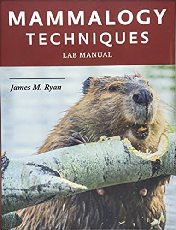Mammalogy Techniques: Lab Manual
 James M Ryan
James M Ryan
Johns Hopkins University Press, £29.50
Over 19 chapters, Mammalogy Techniques is a laboratory manual for the student and tutor. Chapters one and two are dedicated to the primary resources for identification: the skull and teeth. Diagrams, terminology and differences in morphology assist students in the identification and understanding of modifications between mammals. For instance, the Rodentia have unique jaw muscles to provide the power to gnaw through just about anything, including tree trunks, as shown in the front-cover image of a beaver.
Differences in tooth form are probably the easiest way to tell one mammal from another and the author provides exercises for the student to practice tooth identification in chapter two. Each chapter has one or more exercises for the instructor to set as assignments.
Chapter five, though, is specifically for the student, as it is all about keeping a field notebook. The importance of the field notebook is one of the most basic of skills and Ryan even gives the reader a point-by-point list of what to include, such as date and location, so he clearly has experience of taking students into the field.
What else is in the field manual? Chapters six to eight cover how to live trap, prepare specimens and collect mammalian parasites. Parasite infestation is studied because of the impact it has on mammal longevity, reproductive success and disease. Parasite collection’s aim is to identify which parasite infects which host species.
Chapters nine and 10 have mark-recapture studies with statistical estimate methods including data analysis for use in Microsoft Excel and applied software for such data. Sampling, tracking, sound analysis, behaviour and karyotyping add to the rest of the chapters.
The content makes for a book of such a range of mammal study methods it is difficult to think all that can be in just 179 pages including the index.
Pat Sang MRSB


